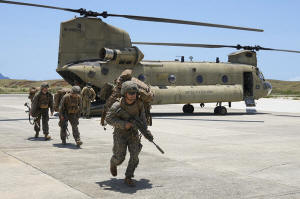Military leaders warn of risks to armed forces' readiness in temporary
funding bill
[March 13, 2025]
By LOLITA C. BALDOR
WASHINGTON (AP) — Military service leaders told senators Wednesday that
passing a temporary budget that keeps defense spending largely flat will
hurt readiness and efforts to modernize the armed forces.
The vice chiefs of the Army, Navy, Marine Corps and Air Force said that
if they don't get additional funding, they at least need the flexibility
to shift money to ensure priorities are covered. Congress has been
unable to get through a full 2025 fiscal year budget and instead has
passed temporary stopgap measures that largely keep funding at 2024
levels.
A bill passed Tuesday by the House would increase defense spending by
about $6 billion and trim $13 billion in non-defense spending, which are
rather flat changes for both categories when compared with an overall
topline of nearly $1.7 trillion in discretionary spending. The
legislation now moves to the Senate.
This would be the first year that Congress hasn’t passed a defense
spending bill and will instead use a full-year continuing resolution,
the military leaders said. They said that continuing the 2024 budget
lines doesn't allow the services to start new contracts, including for
weapon modernization or housing and other improvements.
“Ultimately, the Army can afford a large, ready or modern force, but
with the current budget, it cannot afford all three,” Gen. James Mingus,
vice chief of staff of the Army, told the Senate Armed Services
readiness subcommittee. “Either we provide soldiers the capabilities
needed to win or accept greater risks in other areas.”

He warned that the Army will pay for those risks down the road, “not in
delayed projects or budget adjustments, but in real-world battlefield
consequences. We need to invest in the things and training our soldiers
need for the next fight, not the last fight.”
Other service leaders echoed his warning, noting that shortfalls in
shipbuilding, maintenance and sustainment affect both the Navy and the
Marine Corps.
Adm. James Kilby, vice chief of naval operations, said this “will slow
shipbuilding, including our amphibious warships.”
[to top of second column]
|

U.S. troopers alight from a US Army CH-47 carrying American and
Philippine troops as it lands at the Philippines' northernmost town
of Itbayat, Batanes province during a joint military exercise on
Monday, May 6, 2024. (AP Photo/Aaron Favila, File)

Marine leaders have long complained about the lack of critically
needed amphibious ships that can transport Marines at sea to combat.
As of Wednesday morning, said Gen. Christopher Mahoney, assistant
commandant of the Marine Corps, just 13 of the Navy's 32 amphibious
ships were available for use.
And Air Force Lt. Gen. Adrian L. Spain, deputy chief of staff, said
the continuing resolution will affect combat readiness in his
service “to the tune of about $4 billion.”
President Donald Trump and Defense Secretary Pete Hegseth have both
spoken extensively about the need to focus on military readiness and
lethality. But the government is also facing drastic cuts in
spending and personnel, driven by the Department of Government
Efficiency, or DOGE, run by billionaire Trump adviser Elon Musk.
Senators acknowledged the continuing resolution presents a challenge
for the military, but they provided no clear answer on whether
flexibility will be built in as the spending bill heads to the
Senate this week.
“From a readiness standpoint, none of us think this is helpful. What
would be worse, in my view, is a government shutdown,” said Sen. Dan
Sullivan, R-Alaska.
Sen. Mazie Hirono, D-Hawaii, questioned whether the deployment of
active duty forces to the southern border is impeding training and
readiness because troops are largely erecting barriers and helping
border agents with intelligence, logistics and other tasks.
She said having warfighters “overseeing the stocking of civilian
warehouses and data entry on the (CBP computers)" doesn't sound like
the emphasis on lethality that Hegseth has promised.
All contents © copyright 2025 Associated Press. All rights reserved |